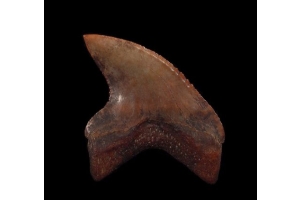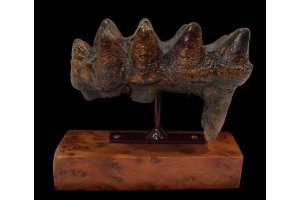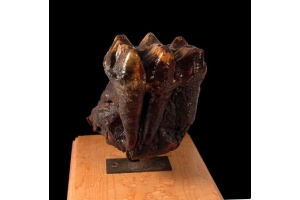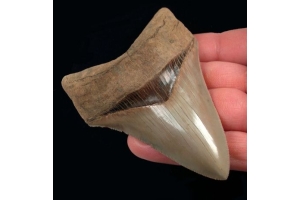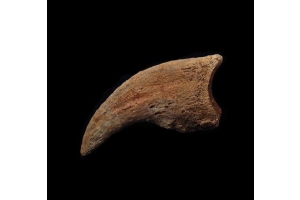Blog
- February 27, 2025
Sharks have been around for over 400 million years, outliving the dinosaurs and surviving multiple mass extinctions. Their fossilized teeth offer a fascinating glimpse into the past, helping scientists and collectors alike piece together ancient marine ecosystems. Among the most sought-after specimens are those that have been preserved in stunning condition, including rare shark teeth from long-extinct species. Some of these fossils, such as a black shark tooth, hold more than just historical significance—they tell stories of evolution, adaptation, and survival.
Why Shark Teeth Dominate the Fossil Record
Unlike bones, which decompose over time, shark teeth have a much better shot at lasting millions of years. Why? Throughout their lives, sharks constantly replace and shed their teeth. meaning each shark can produce thousands of teeth in a lifetime. This abundance increases the odds of fossilization. The teeth, composed of enamel—the hardest substance
- February 25, 2025
In a world dominated by modern marvels, few possessions, like fossils, connect us to the ancient past. Among these, the mastodon tooth fossil is a testament to when colossal creatures roamed the Earth, shaping the landscapes we know today. For collectors, paleontology enthusiasts, and anyone with a love for history, owning a mastodon tooth is an unparalleled opportunity to touch the ancient world. These fossils are not just remnants of the past but gateways to understanding a fascinating chapter of Earth's history.
At Buried Treasure Fossils, we offer a carefully curated selection of authentic mastodon tooth fossils. Each piece is a genuine artifact of prehistoric significance, making it a unique addition to any collection. Whether you’re a skilled collector or just starting your journey into the world of fossils, our commitment to quality and
- February 24, 2025
The prehistoric world holds a captivating allure, filled with creatures that once ruled the land, sea, and sky. Among the most remarkable remains from this era are mastodon teeth, which serve as lasting reminders of these ancient giants. These fossilized teeth provide insights into mastodons' lives and offer essential clues about Earth's distant past. By exploring the fascinating story of mastodon teeth, we uncover a narrative that weaves together history, science, and awe-inspiring wonder.
At Buried Treasure Fossils, we connect enthusiasts, collectors, and researchers with authentic, expertly curated fossils, including mastodon teeth. Our commitment to preserving and sharing these incredible relics honors their legacy while inspiring curiosity and learning.
Understanding Mastodon Teeth
Mastodons were massive, elephant-like creatures that roamed North and Central
- February 17, 2025
Megalodon teeth are some of the most captivating relics of the ancient seas, offering enthusiasts a unique glimpse into a world that existed millions of years ago. These fossils range from an inch to a massive seven inches and are prized by collectors worldwide. If you’re wondering where the best place to find megalodon teeth is, rest assured that the search is thrilling and rewarding. Whether diving deep or scouring the shores, discovering these prehistoric treasures is an adventure.
Why Are Megalodon Teeth So Valuable?
The megalodon, an ancient apex predator, ruled the seas during the Cenozoic Era. Its teeth are among the most durable parts of its body, capable of surviving millions of years while retaining their sharp, triangular form. For collectors and fossil hunters, these teeth symbolize the mystery and
- February 10, 2025
Have you ever wondered what it would be like to hold a piece of ancient history in your hands? Imagine having a real raptor claw fossil directly connected to the fierce predators that once ruled the Earth.
These incredible claws, which were essential tools for hunting and survival, are now among the most prized fossils on the market. If you're a collector or simply someone fascinated by the prehistoric world, a raptor claw could be the ultimate addition to your collection.
Why Are Raptor Claws So Fascinating?
Raptors were fast, intelligent, and formidable hunters. Their claws were one of their most important features, designed to help them catch and tear into their prey. These sharp, curved claws are a perfect symbol of their predatory nature. As fossils, raptor claws offer us a rare glimpse into the past, showing us how these ancient predators lived and hunted millions of years ago.
Owning a raptor claw is more than just a purchase—it's
- February 03, 2025
Imagine owning a piece of history that lived millions of years ago. Velociraptors were one of the most infamous predators of the dinosaur world. If you've always dreamed of having a piece of the past in your collection, you're in luck! Velociraptor claw for sale can now be yours. These ancient claws are not just rare; they carry with them a story that dates back to the Late Cretaceous period, around 75 million years ago.
The Power of the Velociraptor Claw
Velociraptors were fast, intelligent, and feared by many other creatures. Their claws were one of their most powerful weapons. Located on their feet, these sharp, curved claws were used to slash through prey and hunt with precision. Holding a velociraptor claw for sale in your hand means owning a piece of this deadly and cunning creature.
What Makes Velociraptor Claws So Special?
- January 31, 2025
Few relics of the past capture the imagination like the mighty Megalodon tooth. These prehistoric treasures are more than just fossils—they’re windows into an ancient world ruled by one of the largest predators to ever exist. Among the most sought-after finds, North Carolina’s Megalodon teeth stand out for their size, rarity, and stunning features.
Why Megalodon Teeth Are So Special?
Megalodon teeth are valued for more than simply their aesthetic value; they provide insight into the life of a massive shark that ruled the seas millions of years ago. These massive teeth—some larger than a human hand—showcase sharp serrations and an intimidating size, hinting at the sheer power of this extinct giant.
What makes North Carolina’s finds particularly unique? It’s the region’s rich fossil history. Millions of years ago, its coastal areas were underwater, providing the perfect environment for preserving these ancient treasures.
The Hunt
- January 29, 2025
Megalodon teeth have long captivated the curiosity of fossil enthusiasts and collectors alike. These ancient relics provide a glimpse into a prehistoric world dominated by one of the most formidable predators and hold significant value in today's fossil market. For anyone wondering how much a megalodon tooth is worth, the answer depends on its size, quality, and rarity. Let's dive into the fascinating world of these extraordinary fossils.
Why Megalodon Teeth Hold Such Value
The value of a megalodon tooth extends far beyond its size. Collectors often seek well-preserved teeth with minimal damage and clearly visible details. Features like sharp serrations, complete roots, and high-quality enamel significantly increase their worth. For example, an ultra-rare, top-quality tooth from the Meherrin River Copper Red Site might fetch over $4,500.
- January 22, 2025
Shark tooth collecting has always been a fascinating pursuit for enthusiasts of marine history. Among the most sought-after finds are angustidens shark tooth fossils, which captivate collectors due to their unique structure, rarity, and historical significance. These fossils, originating from Otodus angustidens, represent a piece of prehistoric marine life and stand out for their distinctive features and pristine preservation. Let's delve into what makes these fossils special for collectors like us.
The Remarkable Legacy of Otodus Angustidens
Otodus angustidens is the direct ancestor of the extinct Giant White Shark, also known as Otodus megalodon. This lineage places angustidens in a fascinating historical context, making their teeth a window into the evolution of some of the ocean's most formidable predators. Their distinct triangular crowns and fully serrated, sharp side cusps make them stand out.
- January 16, 2025
Madagascar is famous for its unique wildlife, but did you know it's also home to some of the most beautiful and fascinating fossils? Among these ancient treasures are Madagascar Ammonites, which have become a favorite for collectors and fossil enthusiasts alike. These spiral-shaped fossils hold secrets from millions of years ago and continue to captivate people around the world.
What Makes Ammonites So Special?
During the dinosaur era, a genus of marine mollusks known as ammonites went extinct. What makes them stand out is their stunning spiral shells and incredible preservation. These fossils come in a wide range of colors, including rich browns, red, & golden tones, and even iridescent ones. The beauty of their shape and pattern makes them not just fossils, but works of art from nature’s past.
Each Ammonite fossil is a snapshot of ancient life



